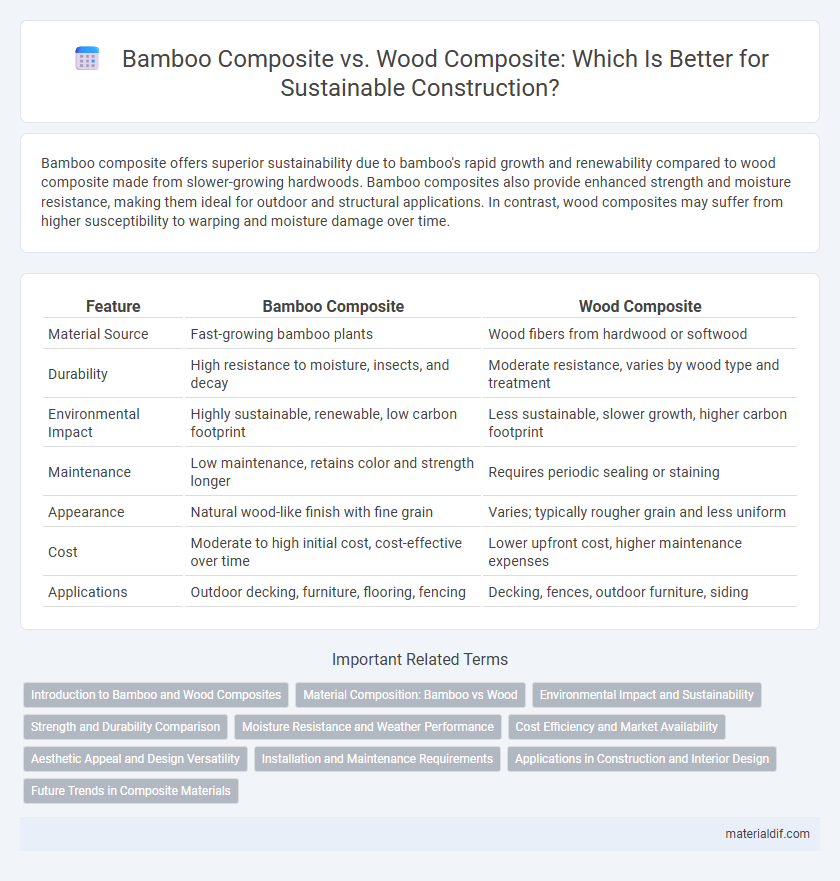Bamboo composite offers superior sustainability due to bamboo's rapid growth and renewability compared to wood composite made from slower-growing hardwoods. Bamboo composites also provide enhanced strength and moisture resistance, making them ideal for outdoor and structural applications. In contrast, wood composites may suffer from higher susceptibility to warping and moisture damage over time.
Table of Comparison
| Feature | Bamboo Composite | Wood Composite |
|---|---|---|
| Material Source | Fast-growing bamboo plants | Wood fibers from hardwood or softwood |
| Durability | High resistance to moisture, insects, and decay | Moderate resistance, varies by wood type and treatment |
| Environmental Impact | Highly sustainable, renewable, low carbon footprint | Less sustainable, slower growth, higher carbon footprint |
| Maintenance | Low maintenance, retains color and strength longer | Requires periodic sealing or staining |
| Appearance | Natural wood-like finish with fine grain | Varies; typically rougher grain and less uniform |
| Cost | Moderate to high initial cost, cost-effective over time | Lower upfront cost, higher maintenance expenses |
| Applications | Outdoor decking, furniture, flooring, fencing | Decking, fences, outdoor furniture, siding |
Introduction to Bamboo and Wood Composites
Bamboo composites combine natural bamboo fibers with resins to create a strong, eco-friendly alternative to traditional wood composites, which are typically made from wood fibers and plastic binders. Bamboo's fast growth rate and high tensile strength make bamboo composites more sustainable and durable compared to conventional wood composites. Both materials are widely used in construction, furniture, and flooring, but bamboo composites offer enhanced biodegradability and lower carbon footprints.
Material Composition: Bamboo vs Wood
Bamboo composite consists primarily of natural bamboo fibers combined with eco-friendly resins, offering a lightweight yet durable material with high tensile strength. Wood composite typically incorporates wood fibers or sawdust mixed with plastic polymers, resulting in a denser material with moderate resistance to moisture and decay. Bamboo composites outperform wood composites in sustainability and biodegradability due to bamboo's rapid growth rate and renewable sourcing.
Environmental Impact and Sustainability
Bamboo composite materials boast a significantly lower environmental impact compared to traditional wood composites due to bamboo's rapid growth rate and higher carbon sequestration capacity, enabling faster renewal and reduced deforestation. Bamboo's natural resistance to pests and fungi reduces the need for chemical treatments commonly used in wood composites, leading to less chemical runoff and toxicity. Sustainable harvesting practices and the ability to regrow bamboo within 3-5 years contribute to its superior sustainability profile over slower-growing hardwood species used in wood composites.
Strength and Durability Comparison
Bamboo composite demonstrates superior strength compared to wood composite due to its natural fibrous structure, resulting in higher tensile and compressive strength. This material also offers enhanced durability, resisting moisture, insects, and decay more effectively than traditional wood composites. Bamboo composites maintain structural integrity longer, making them ideal for outdoor and high-stress applications.
Moisture Resistance and Weather Performance
Bamboo composite exhibits superior moisture resistance compared to wood composite due to its natural silica content and dense fiber structure that inhibits water absorption and swelling. The enhanced weather performance of bamboo composite ensures durability in varying climates, resisting rot, mold, and UV degradation more effectively than traditional wood composites. These properties make bamboo composite an ideal choice for outdoor applications where long-term exposure to moisture and harsh weather conditions is expected.
Cost Efficiency and Market Availability
Bamboo composite materials offer superior cost efficiency compared to traditional wood composites due to faster growth rates and renewable harvesting cycles, reducing raw material expenses. Market availability of bamboo composites is expanding rapidly, driven by increased consumer demand and sustainable building practices, whereas wood composites face supply limitations and higher price volatility. The scalability of bamboo plantations ensures consistent production volumes, making bamboo composites a more reliable and economical choice in various construction and furniture applications.
Aesthetic Appeal and Design Versatility
Bamboo composite offers a natural, warm aesthetic with fine grain patterns that enhance visual appeal, making it ideal for modern and rustic designs. Compared to wood composite, bamboo provides greater design versatility due to its uniform texture and ability to be shaped into intricate patterns without compromising strength. This flexibility allows architects and designers to create innovative, sustainable structures with a distinctive, stylish finish.
Installation and Maintenance Requirements
Bamboo composite typically requires less maintenance compared to wood composite due to its natural resistance to moisture, insects, and decay, reducing the need for frequent sealing or staining. Installation of bamboo composite boards is straightforward thanks to their uniform size and pre-finished surfaces, minimizing cutting and sanding time. Wood composite may demand additional preparation and ongoing upkeep, including protective coatings to prevent warping and rotting in humid environments.
Applications in Construction and Interior Design
Bamboo composite offers superior tensile strength and flexibility compared to wood composite, making it ideal for structural applications such as flooring, wall panels, and roofing in construction. Its natural resistance to moisture, insects, and decay enhances durability in both indoor and outdoor interior design projects. Wood composite, while versatile and cost-effective, generally suits non-load-bearing elements like cabinetry and decorative trims due to lower strength and susceptibility to environmental damage.
Future Trends in Composite Materials
Bamboo composite offers superior sustainability and faster renewability compared to traditional wood composites, driving innovation in eco-friendly building materials. Advances in bio-based resins and enhanced fiber treatments are improving the durability and mechanical properties of bamboo composites, positioning them as a key player in future composite material markets. Industry trends highlight increasing adoption of bamboo composites for construction and furniture due to their lower carbon footprint and enhanced performance characteristics.
Bamboo composite vs Wood composite Infographic

 materialdif.com
materialdif.com